-
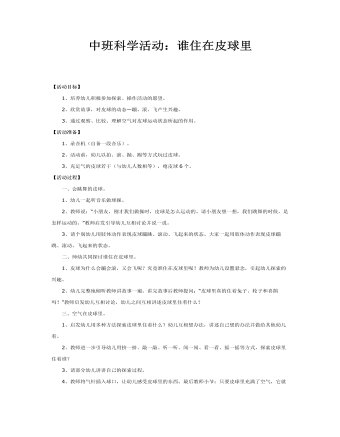
中班科学活动:谁住在皮球里课件教案
2、欣赏故事,对皮球的动态—蹦、滚、飞产生兴趣。3、通过观察、比较、理解空气对皮球运动状态所起的作用。【活动准备】1、录音机(自备一段音乐)。2、活动前,幼儿以拍、滚、抛、踢等方式玩过皮球。3、充足气的皮球若干(与幼儿人数相等),瘪皮球6个。【活动过程】 一、会跳舞的皮球。1、幼儿一起听音乐做球操。2、教师说:“小朋友,刚才我们做操时,皮球是怎么运动的。请小朋友想一想,我们跳舞的时候,是怎样运动的。”教师启发引导幼儿互相讨论并说一说。3、请个别幼儿用肢体动作表现皮球蹦跳、滚动、飞起来的状态。大家一起用肢体动作表现皮球蹦跳、滚动、飞起来的状态。
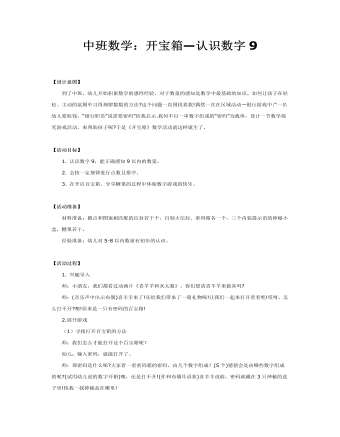
中班数学:开宝箱—认识数字9课件教案
【活动目标】1. 认识数字9,能正确感知9以内的数量。2. 会按一定规律进行点数且排序。3. 在开启百宝箱、分享糖果的过程中体验数字游戏的快乐。 【活动准备】 材料准备:圆点和图案相匹配的信封若干个,自制大信封、密码箱各一个,三个内装提示语的神秘小盒,糖果若干。 经验准备:幼儿对5-8以内数量有初步的认识。 【活动过程】1. 兴趣导入 师:小朋友,我们都看过动画片《喜羊羊和灰太狼》。你们想请喜羊羊来做客吗? 师:(音乐声中出示布偶)喜羊羊来了!还给我们带来了一箱礼物呢!让我们一起来打开看看吧!哎呀,怎么打不开?噢!原来是一只有密码的百宝箱!2.展开游戏 (1)寻找打开百宝箱的方法 师:我们怎么才能打开这个百宝箱呢? 幼儿:输入密码,就能打开了。 师:那密码是什么呢?大家看一看密码箱的密码,由几个数字组成?(5个)猜猜会是由哪些数字组成的呢?(试用幼儿说的数字开箱)噢,还是打不开!(作和布偶耳语状)喜羊羊说啦,密码就藏在3只神秘的盒子里!快找一找神秘盒在哪里!
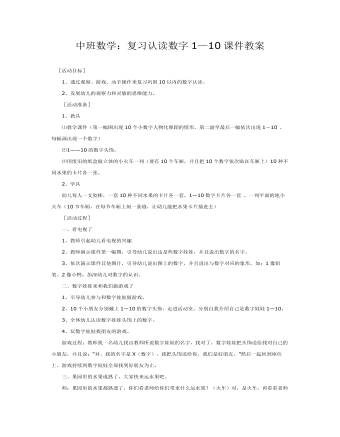
中班数学:复习认读数字1—10课件教案
2、发展幼儿的观察力和灵敏的思维能力。 [活动准备]1、教具⑴教学课件(第一幅图出现10个小数字人物化舞蹈的情形,第二副至最后一幅依次出现1-10 ,每幅画出现一个数字)⑵1——10的数字头饰。⑶用废旧的纸盒做立体的小火车一列(要有10个车厢,并且把10个数字依次贴在车厢上)10种不同水果的卡片各一张。2、学具 幼儿每人一支胶棒,一套10种不同水果的卡片各一套,1—10数字卡片各一套,一列平面的地小火车(10节车厢,在每节车厢上刻一条缝,让幼儿能把水果卡片插进去)
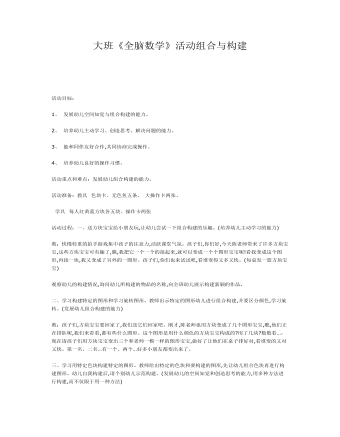
大班全脑数学:组合与构建课件教案
2、 培养幼儿主动学习、创造思考、解决问题的能力。3、 能和同伴友好合作,共同协商完成操作。4、 培养幼儿良好的操作习惯。活动重点和难点:发展幼儿组合构建的能力。活动准备:教具 色块卡、无色鱼五条、大操作卡两张、 学具 每人红黄蓝方块各五块、操作卡两张活动过程:一、送方块宝宝给小朋友玩,让幼儿尝试一下组合构建的乐趣。(培养幼儿主动学习的能力)教:快慢轻重的拍手游戏集中孩子的注意力,活跃课堂气氛。孩子们,你们好,今天陈老师带来了许多方块宝宝,这些方块宝宝可有趣了,瞧,我把它一个一个的接起来,就可以变成一个个图形宝宝呢!看我变成这个图形,再接一块,我又变成了另外的一图形。孩子们,你们也来试试吧,看谁变得又多又快。(每桌发一篮方块宝宝)观察幼儿的构建情况,询问幼儿所构建的物品的名称,向全班幼儿展示构建新颖的作品。
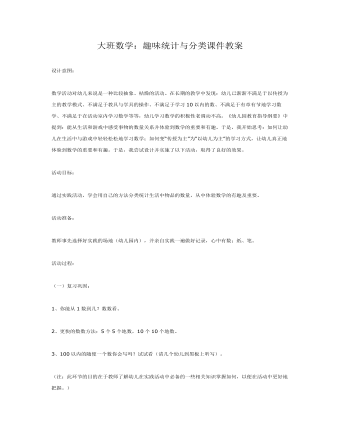
大班数学:趣味统计与分类课件教案
活动目标:通过实践活动,学会用自己的方法分类统计生活中物品的数量,从中体验数学的有趣及重要。活动准备:教师事先选择好实践的场地(幼儿园内),并亲自实践一遍做好记录,心中有数;纸、笔。活动过程:(一)复习巩固:1、你能从1数到几?数数看。2、更快的数数方法:5个5个地数,10个10个地数。3、100以内的随便一个数你会写吗?试试看(请几个幼儿到黑板上听写)。(注:此环节的目的在于教师了解幼儿在实践活动中必备的一些相关知识掌握如何,以便在活动中更好地把握。)(二)联 系生活:1、在生活中,你碰到什么东西要用数来数?举例子。2、在幼儿园里也藏了许多数,请小朋友们说说。3、用什么方法统计方便?(每5个或10个记录一次,然后5个5个或10个10个地数;列表统计等)
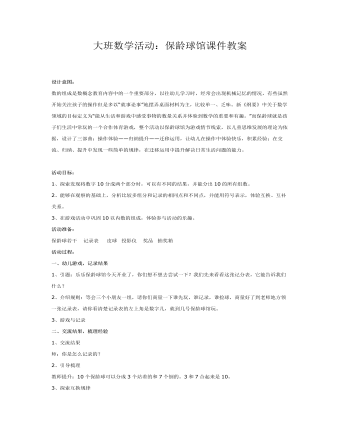
大班数学活动:保龄球馆课件教案
活动目标:1、探索发现将数字10分成两个部分时,可以有不同的结果,并能分出10的所有组数。2、能够在观察的基础上,分析比较多组分和记录的相同点和不同点,并能用符号表示,体验互换、互补关系。3、在游戏活动中巩固10以内数的组成,体验参与活动的乐趣。 活动准备:保龄球若干 记录表 皮球 投影仪 奖品 抽奖箱 活动过程:一、幼儿游戏,记录结果1、引题:乐乐保龄球馆今天开业了,你们想不想去尝试一下?我们先来看看这张记分表,它能告诉我们什么?2、介绍规则:等会三个小朋友一组,请你们商量一下谁先玩,谁记录,谁捡球,商量好了到老师地方领一张记录表,请你看清楚记录表的左上角是数字几,就到几号保龄球馆玩。3、游戏与记录
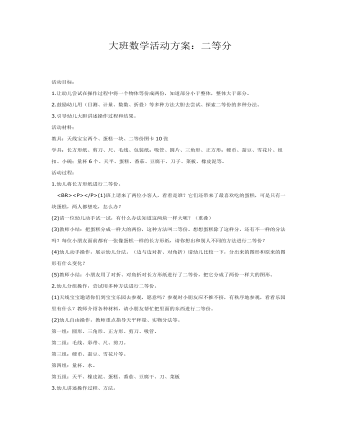
大班数学活动方案:二等分课件教案
2.鼓励幼儿用(目测、计量、数数、折叠)等多种方法大胆去尝试、探索二等份的多种分法。3.引导幼儿大胆讲述操作过程和结果。活动材料;教具:天线宝宝两个、蛋糕一块、二等份图卡10张学具:长方形纸、剪刀、尺、毛线、包装纸;吸管、圆片、三角形、正方形;硬币、蚕豆、雪花片、纽扣、小碗;量杯6个、天平、蛋糕、番茄、豆腐干、刀子、菜板、橡皮泥等。活动过程:1.幼儿将长方形纸进行二等份。 (1)班上请来了两位小客人,看看是谁?它们还带来了最喜欢吃的蛋糕,可是只有一块蛋糕,两人都想吃,怎么办?(2)请一位幼儿动手试一试,有什么办法知道这两块一样大呢?(重叠)(3)教师小结:把蛋糕分成一样大的两份,这种方法叫二等份。想想蛋糕除了这样分,还有不一样的分法吗?每位小朋友面前都有一张像蛋糕一样的长方形纸,请你想出和别人不同的方法进行二等份?(4)幼儿动手操作,展示幼儿分法。(边与边对折、对角折)请幼儿比较一下,分出来的图形和原来的图形有什么变化?(5)教师小结:小朋友用了对折、对角折对长方形纸进行了二等份,把它分成了两份一样大的图形。
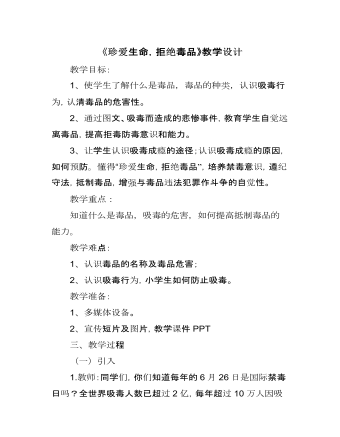
《珍爱生命远离毒品》教学设计教案
教学目标:1、使学生了解什么是毒品,毒品的种类,认识吸毒行为,认清毒品的危害性。2、通过图文、吸毒而造成的悲惨事件,教育学生自觉远离毒品,提高拒毒防毒意识和能力。3、让学生认识吸毒成瘾的途径;认识吸毒成瘾的原因,如何预防。懂得“珍爱生命,拒绝毒品”,培养禁毒意识,遵纪守法,抵制毒品,增强与毒品违法犯罪作斗争的自觉性。教学重点:知道什么是毒品,吸毒的危害,如何提高抵制毒品的能力。
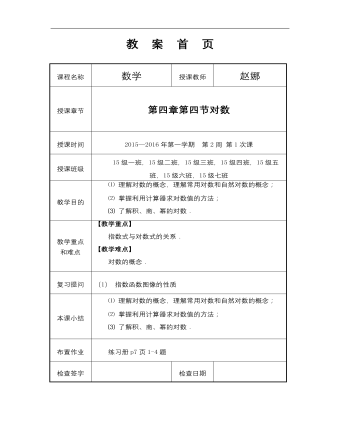
【高教版】中职数学基础模块上册:4.3《对数》优秀教案
课程名称数学授课教师赵娜授课章节第四章第四节对数授课时间2015—2016年第一学期 第2周第1次课授课班级15级一班,15级二班,15级三班,15级四班,15级五班,15级六班,15级七班教学目的⑴ 理解对数的概念,理解常用对数和自然对数的概念; ⑵ 掌握利用计算器求对数值的方法; ⑶了解积、商、幂的对数.教学重点 和难点【教学重点】 指数式与对数式的关系. 【教学难点】 对数的概念.复习提问(1) 指数函数图像的性质本课小结⑴ 理解对数的概念,理解常用对数和自然对数的概念; ⑵ 掌握利用计算器求对数值的方法; ⑶了解积、商、幂的对数.布置作业练习册p7页1-4题检查签字 检查日期
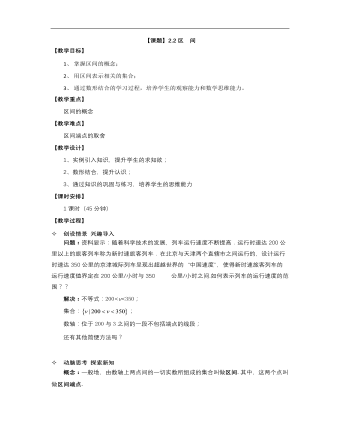
【高教版】中职数学基础模块上册:2.2《区间》优秀教案
【教学目标】1、掌握区间的概念;2、用区间表示相关的集合;3、通过数形结合的学习过程,培养学生的观察能力和数学思维能力。【教学重点】区间的概念【教学难点】 区间端点的取舍【教学设计】 1、实例引入知识,提升学生的求知欲;2、数形结合,提升认识;3、通过知识的巩固与练习,培养学生的思维能力【课时安排】 1课时(45分钟)【教学过程】² 创设情景 兴趣导入问题:资料显示:随着科学技术的发展,列车运行速度不断提高.运行时速达200公里以上的旅客列车称为新时速旅客列车.在北京与天津两个直辖市之间运行的,设计运行时速达350公里的京津城际列车呈现出超越世界的“中国速度”,使得新时速旅客列车的运行速度值界定在200公里/小时与350 公里/小时之间.如何表示列车的运行速度的范围??解决:不等式:200<v<350;集合:;数轴:位于200与3之间的一段不包括端点的线段;还有其他简便方法吗?
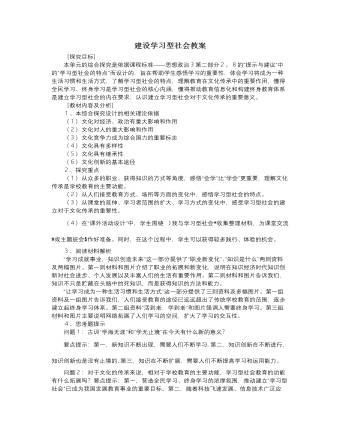
人教版高中政治必修3建设学习型社会教案
三、第三阶段。课后感悟与收获1、让学生以“走向学习型社会”为题,将在收集与整理、展示与交流两个环节中获得的体验和感悟,以心得体会的形式写一篇小论文。2、办一期专栏或黑板报,将优秀小论文作集中展示与交流。(进行理论总结,将实践与理论相结合,让科学理论更好地指导实践。充分挖掘学生潜力,增强学生的自信)[评析]新课程理念之一就是政治课不应只局限于课堂上的教与学。把综合探究课与研究性学习相结合,不失为一种有益的尝试。传统的学习方式把学习建立在客观性、受动性、依赖性的基础上,把学生看成一个没有感情的接受容器,这种学习会窒息学生的思维和智力,成为学生发展的障碍。单元探究活动的开展就是要转变学生的学习方式,关注学生的学习过程,使得探究过程成为学生发现问题、提出问题、分析问题、解决问题的过程,培养学生的创新精神和实践能力。本教案的第一阶段充分发挥了学生的主动性。

新人教版高中英语必修3Unit 2 Morals and Virtues教学设计二
Activity 41. Students complete the task of activity 4, then teachers and students check the answers. 2. The teacher organized the students to work together and asked them to use the tables and mind maps sorted out before to retold the important choices in Lin Qiaozhi's life and their resultsStep 5 Language points1. The teacher asks the students to read the text carefully, find out the core words and long and difficult sentences in the text and draw lines, understand the use of vocabulary, and analyze the structure of long and difficult sentences. 2. The teacher explains and summarizes the usage of core vocabulary and asks the students to take notes. 3. The teacher analyzes and explains the long and difficult sentences that the students don't understand, so that the students can understand them better. Step 6 Homework1. Read the text again, in-depth understanding of the text; 2. Master the use of core vocabulary and understand the long and difficult sentences. 3. Complete relevant exercises in the guide plan. 1、通过本节内容学习,学生是否理解和掌握阅读文本中的新词汇的意义与用法;2、通过本节内容学习,学生能否结合文本特点总结林巧稚的人生原则和人格品质特征;3、通过本节内容学习,学生能否针对人生抉择发表自己的看法;能否全面地、客观地、理性地看待问题,进而对道德和人性有更加深入的思考和理解。

新人教版高中英语必修3Unit 2 Morals and Virtues教学设计三
The joke set her crying.这个玩笑使她哭起来。Step 5 ReadingActivity 31. Students read the small text in activity 3. The teacher provides several small questions to check whether students understand the content of the text and the ideographic function of the -ing form in the text.*Where are those people?*Why did Dr Bethune come to China?*How did he help the Chinese people during the war?*What did Chairman Mao Zedong say about him?2. Ss try to rewrite some sentences using the -ing form. Then check the answers. When checking the answers, the teacher can ask different students to read the rewritten sentences and give comments.Answers:1. he became very interested in medicine, deciding to become a doctor.2. …after hearing that many people were dying in the war.3. Helping to organise hospitals, he taught doctors and nurses, and showed people how to give first aid./ He helped to organise hospitals, teaching doctors and nurses, and showing people how to give first aid.4. …praising Dr Bethune as a hero to be remembered in China.Step 6 PracticeActivity 4Students complete grammar activities 2 and 3 on page 69 of the workbook.Step 6 Homework1. Understand and master the functions and usage of the -ing form;2. Finish the other exercises in Using structures.1、通过本节内容学习,学生是否理解和掌握动词-ing形式作宾语补足语语和状语语的功能和意义;2、通过本节内容学习,学生能否正确使用动词-ing形式描述人物的行为、动作及其经历;3、通过本节内容学习,学生能否独立完成练习册和导学案中的相关练习。

新人教版高中英语必修3Unit 3 Diverse Cultures教学设计二
(2)Consolidate key vocabulary.Ask the students to complete the exercises of activity 6 by themselves. Then ask them to check the answers with their partners.(The first language:Damage of the 1906 San Francisco earthquake and fire.A second language: Yunnan - one of the most diverse provinces in China).Step 5 Language points1. The teacher asks the students to read the text carefully, find out the more words and long and difficult sentences in the text and draw lines, understand the use of vocabulary, and analyze the structure of long and difficult sentences.2. The teacher explains and summarizes the usage of core vocabulary and asks the students to take notes.3. The teacher analyzes and explains the long and difficult sentences that the students don't understand, so that the students can understand them better.Step 6 Homework1. Read the text again, in-depth understanding of the text;2. Master the use of core vocabulary and understand the long and difficult sentences.3. Complete relevant exercises in the guide plan.1、通过本节内容学习,学生是否理解和掌握阅读文本中的新词汇的意义与用法;2、通过本节内容学习,学生能否结合文本特点了解文章的结构和作者的写作逻辑;3、通过本节内容学习,学生能否了解旧金山的城市风貌、文化特色,以及加利福尼亚州的历史,体会多元文化对美国的影响。

新人教版高中英语必修3Unit 4 Space Exploration-Discovering Useful Structures导学案
【点津】 1.不定式的复合结构作目的状语 ,当不定式或不定式短语有自己的执行者时,要用不定式的复合结构?即在不定式或不定式短语之前加 for +名词或宾格代词?作状语。He opened the door for the children to come in. 他开门让孩子们进来。目的状语从句与不定式的转换 英语中的目的状语从句,还可以变为不定式或不定式短语作状语,从而使句子在结构上得以简化。可分为两种情况: 1?当目的状语从句中的主语与主句中的主语相同时,可以直接简化为不定式或不定式短语作状语。We'll start early in order that/so that we may arrive in time. →We'll start early in order to/so as to arrive in time. 2?当目的状语从句中的主语与主句中的主语不相同时,要用动词不定式的复合结构作状语。I came early in order that you might read my report before the meeting. →I came early in order for you to read my report before the meeting.

新人教版高中英语选修2Unit 2 Learning about Language教学设计
The activity theme of this section is to design various activities around the key words in the first text. Therefore, the activities require students to pay attention to the spelling of words. On the other hand, let students grasp the meaning of words more accurately through sentences and short texts. This kind of teaching design also helps to improve the ability of using English thinking.1. Cultivating students' ability to use word formation to induce and memorize vocabulary, and the ability to use lexical chunks to express meaning.2. Guide the students to think independently and use the correct form of words to complete sentences3. Cultivate students' habit of using lexical chunks to express language completely, guide students to draw words in sentences quickly, pay attention to word collocation, so as to accumulate more authentic expressions4. Instruct students to create sentences with the chunks.1. Enable students to use the language points in the real situation or specific contexts flexibly and appropriately.2. Guiding the Ss to use unit topic words and the sentence patterns in a richer context.Step1: Think of a word that best fits each definition.1. to remember sth2.to accept, admit, or recognize sth or the truth/existence of sth3. the process of changing sth or yourself to suit a new situation4 .to make sb feel less worried or unhappy5. a strong desire to achieve sth

新人教版高中英语选修2Unit 3 Reading for writing教学设计
The theme of this part is to write an article about healthy diet. Through reading and writing activities, students can accumulate knowledge about healthy diet, deepen their understanding of the theme of healthy diet, and reflect on their own eating habits. This text describes the basic principles of healthy diet. The author uses data analysis, definition, comparison, examples and other methods. It also provides a demonstration of the use of conjunctions, which provides important information reference for students to complete the next collaborative task, writing skills, vivid language materials and expressions.1. Teach Ss to learn and skillfully use the new words learned from the text.2. Develop students’ ability to understand, extract and summarize information.3. Guide students to understand the theme of healthy diet and reflect on their own eating habits.4. To guide students to analyze and understand the reading discourse from the aspects of theme content, writing structure, language expression, etc., 5. Enable Ss to write in combination with relevant topics and opinions, and to talk about their eating habits.1. Guide students to analyze and understand the reading discourse from the aspects of theme content, writing structure, language expression, etc.2. Enable them to write in combination with relevant topics and opinions, and to talk about their eating habits.3. Guide the students to use the cohesive words correctly, strengthen the textual cohesion, and make the expression fluent and the thinking clear.Step1: Warming upbrainstorm some healthy eating habits.1.Eat slowly.2.Don’t eat too much fat or sugar.3.Eat healthy food.4.Have a balanced diet.Step2: Read the passage and then sum up the main idea of each paragraph.

新人教版高中英语选修2Unit 4 Learning about Language教学设计
This section guides students to pay attention to the typical context of vocabulary use, helps students accumulate vocabulary around the key vocabulary of this unit, and uses the learned words and word chunks in different contexts to deeply understand their meaning and usage, so as to achieve the purpose of review and consolidation.The teaching design activities aim to guide students to pay attention to the typical context in which the target vocabulary is used, as well as the common vocabulary used in collocation, so that students can complete the sentence with correct words. In terms of vocabulary learning strategies, this unit focuses on cultivating students' ability to pay attention to collocation of words and to use word blocks to express meaning.For vocabulary learning, it is not enough just to know the meaning of a single word, but the most important thing is to master the common collocations of words, namely word blocks.Teachers should timely guide students to summarize common vocabulary collocation, such as verb and noun collocation, verb and preposition collocation, preposition and noun collocation, and so on.1. Guide students to understand and consolidate the meaning and usage of the vocabulary in the context, 2. Guide the students to use the unit topic vocabulary in a richer context3. Let the students sort out and accumulate the accumulated vocabulary, establishes the semantic connection between the vocabulary,4. Enable students to understand and master the vocabulary more effectivelyGuiding the Ss to use unit topic words and the sentence patterns in a richer context.

新人教版高中英语选修2Unit 5 Using langauge-Listening教学设计
The theme of this section is to learn how to make emergency calls. Students should learn how to make emergency calls not only in China, but also in foreign countries in English, so that they can be prepared for future situations outside the home.The emergency telephone number is a vital hotline, which should be the most clear, rapid and effective communication with the acute operator.This section helps students to understand the emergency calls in some countries and the precautions for making emergency calls. Through the study of this section, students can accumulate common expressions and sentence patterns in this context. 1.Help students accumulate emergency telephone numbers in different countries and learn more about first aid2.Guide the students to understand the contents and instructions of the telephone, grasp the characteristics of the emergency telephone and the requirements of the emergency telephone.3.Guide students to understand the first aid instructions of the operators.4.Enable Ss to make simulated emergency calls with their partners in the language they have learned1. Instruct students to grasp the key information and important details of the dialogue.2. Instruct students to conduct a similar talk on the relevant topic.Step1:Look and discuss:Match the pictures below to the medical emergencies, and then discuss the questions in groups.
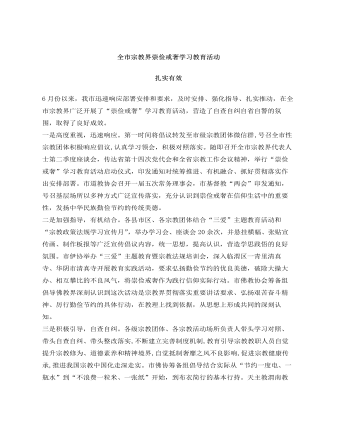
全市宗教界崇俭戒奢学习教育活动总结汇报
天主教渭南教区举行“崇俭戒奢”教育活动座谈会,进一步统一思想认识,清醒认识宗教领域贪大求奢、借教敛财、铺张浪费等不良风气的严重危害,突出问题导向,坚持自查自改,要求秉持俭朴理念,发扬勤俭节约、朴实无华、清净庄严等优良传统,使厉行节约、崇尚简朴的理念在全市天主教界蔚然成风。四是固化经验,常抓抓常。按照省民宗委、各全省性宗教团体统一部署要求和总体安排,一是结合“三爱”主题教育和爱国主义教育活动,广泛深入推进“崇俭戒奢”宣传教育,以实际行动响应倡议,以实际成效树立形象,扎实推进我国宗教中国化。二是引导各级宗教团体持续拓展中国化内涵,把“三爱”主题教育与“四进”活动相结合,突出自身特点、时代精神、中国特色,推动“崇俭戒奢”教育活动深入人心、落地见效。三是督导各宗教场所提高站位、深化认识,发扬宗教适应社会、服务社会的优良传统,增强政治自觉和行动自觉,为社会主义现代化和中华民族伟大复兴更好的发挥宗教积极作用。


